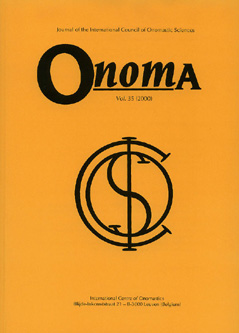 previous article in this issue previous article in this issue | next article in this issue  |

|
Document Details : Title: Frisian Place-Names and Place-Names in Friesland Author(s): VERSLOOT, Arjen Journal: Onoma Volume: 46 Date: 2011 Pages: 127-150 DOI: 10.2143/ONO.46.0.2975532 Abstract : This article sketches etymological, distributional and judicial aspects of placenames in the Frisian regions of the Netherlands and Germany. As a result of settlement history, a number of name suffixes is overrepresented in the Frisian regions: -haim, -ing > -ens, -werd, -werf and additionally –büll in North Friesland. The Frisian onomastic landscape is not unique in the application of these name types, but rather in the specific cocktail of the types and their high densities. Friesland’s names bear witness of a massive resettlement in the aftermath of the Great Migrations. The second part of the article shows how Frisian names are linguistically adopted and partly assimilated in the adjacent languages Dutch and German. Dutch and German exonyms for Frisian place-names show a mixture of archaic forms and superficial phonological and morphological replacement. The trend seems to be: the larger the place, the older the exonym. As Frisian has had the status of a minority language since many centuries, Frisian endonyms are hardly used as official names in the Netherlands and Germany. An exception is found in the Dutch province of Fryslân, where Frisian endonyms have been adopted as official names since the fifties of the last century. Although highly symbolic in its impact, this aspect of language emancipation has been the object of severe debates and reluctant acceptance by Dutch state authorities. L’article esquisse des aspects étymologiques, aréologiques et judiciaires des noms de lieux dans les régions frisonnes des Pays-Bas et d’Allemagne. Issus de l’histoire du peuplement, un certain nombre de suffixes toponymiques est surreprésenté dans ces régions: haim, -ing > -ens, -werd, -werf et aussi -büll en Frise du Nord. Si la toponymie frisonne n’est pas la seule à présenter ces types de noms, elle a pour spécificité leur mélange et leur forte densité. Les noms frisons témoignent d’un repeuplement massif au lendemain des Grandes Migrations. La seconde partie de l’article montre comment les noms frisons sont linguistiquement adoptés et partiellement assimilés dans les langues hollandaise et allemande voisines. Les exonymes hollandais et allemands pour les noms de lieux frisons révèlent un mélange de formes archaïques et de remplacement phonologique et morphologique superficiel. La tendance semble être la suivante: plus le lieu est grand, plus l’exonyme est ancien. Dans la mesure où le frison a eu le statut d’une langue minoritaire pendant des siècles, les endonymes frisons ne semblent guère usités comme noms officiels dans les Pays-Bas et en Allemagne. On en trouve une exception dans la province néerlandaise de Frise, où les endonymes frisons ont été adoptés comme noms officiels depuis les années 1950. Bien que fort symbolique dans son impact, cet aspect de l’émancipation langagière a fait l’objet de sévères débats et d’une acceptation réticente par les autorités publiques néerlandaises. Der Artikel umreißt etymologische, distributionelle und juristische Aspekte von Ortsnamen in den friesischen Regionen der Niederlande und Deutschlands. Als Folge der Siedlungsgeschichte ist eine Reihe von Suffixen in den friesischen Gebieten überrepräsentiert: -haim, -ing > -ens, -werd, -werf; in Nordfriesland zusätzlich -büll. Die friesische Namenlandschaft ist weniger einzigartig hinsichtlich der Verwendung dieser Namentypen, als vielmehr bezüglich deren spezifischer Mischung und hohen Dichte. Die Namen Frieslands sind Zeugen einer massiven Wiederbesiedlung im unmittelbaren Anschluss an die Völkerwanderung. Der zweite Teil des Artikels zeigt, wie friesische Namen sprachlich adaptiert und teilweise an die benachbarten Sprachen Niederländisch und Deutsch assimiliert werden. Deutsche und niederländische Exonyme für friesische Orts namen weisen eine Mischung aus archaischen Formen und oberflächlicher phonologischer und morphologischer Substitution auf. Es ergibt sich scheinbar folgende Tendenz: je größer die Siedlung, umso älter das Exonym. Da Friesisch seit vielen Jahrhunderten den Status einer Minderheitensprache besitzt, werden friesische Endonyme in den Niederlanden und in Deutschland kaum als offizielle Namen verwendet. Eine Ausnahme stellt die niederländische Provinz Fryslân dar, in der friesische Endonyme seit den fünfziger Jahren des vergangenen Jahrhunderts als offizielle Namen angenommen wurden. Wenn auch in hohem Maße mit symbolischer Bedeutung, ist dieser Aspekt der Sprachemanzipation Gegenstand hartnäckiger Debatten gewesen und nur mit großem Widerwillen von den niederländischen Behörden akzeptiert worden. |
|
